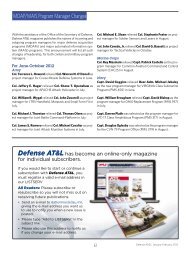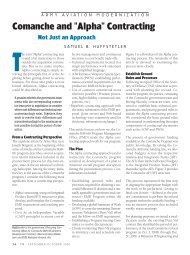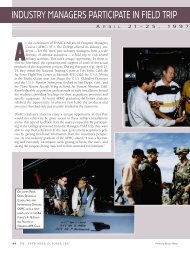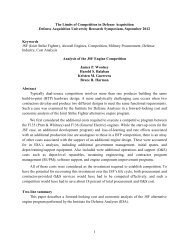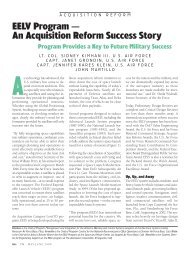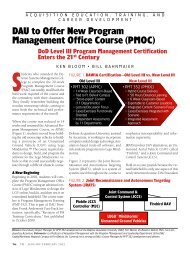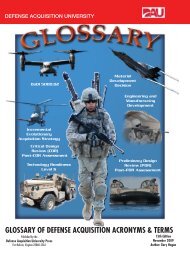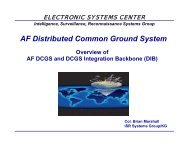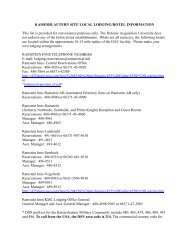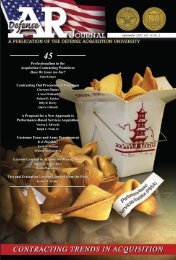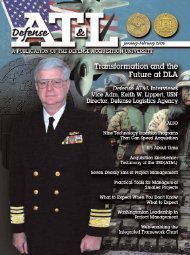Defense ARJ - Defense Acquisition University
Defense ARJ - Defense Acquisition University
Defense ARJ - Defense Acquisition University
Create successful ePaper yourself
Turn your PDF publications into a flip-book with our unique Google optimized e-Paper software.
<strong>Defense</strong> <strong>Acquisition</strong> Review Journal<br />
136<br />
finDinGs<br />
The eight findings presented here are the result of survey data from several program<br />
offices and other support material, which allowed the authors to draw conclusions that<br />
the information and techniques would help acquisition organizations drive favorable<br />
outcomes in their incentive programs. The intention is to have acquisition organizations<br />
review all of the findings in a holistic manner to truly drive favorable outcomes.<br />
reGulatory GuiDance relatinG to incentiVe contractinG is<br />
sufficient<br />
Program managers and contracting officers interviewed supported the view that<br />
the Federal <strong>Acquisition</strong> Regulation (FAR) and the <strong>Defense</strong> Federal <strong>Acquisition</strong> Regulation<br />
Supplement (DFARS) were clear and complete. The problem is that in many<br />
cases, these regulations are not followed when a specific situation occurs that requires<br />
a decision regarding incentive contracting. For example, cost-plus-award-fee (CPAF)<br />
contracts certainly have their place in an acquisition professional’s tool kit, but FAR<br />
16.405-2(b) states that a “cost-plus-award-fee contract is suitable for use when the<br />
work to be performed is such that it is neither feasible nor effective to devise predetermined<br />
objective incentive targets applicable to cost, technical performance, or<br />
Fundamental to making a good business decision on which<br />
incentive tool will yield the desired behavior is a thorough<br />
knowledge of program risk and contract types, and<br />
particularly how contract type impacts risk.<br />
schedule” (FAR, April 2008). It also goes on to further define more specific considerations<br />
for application. The logic behind the FAR verbiage is that the first choice to be<br />
considered is not award fee, but incentive fee using predetermined objective incentive<br />
targets applicable to cost, technical performance, or schedule. Given this logic, one<br />
could reasonably conclude that the DoD would use more incentives with predetermined<br />
objectives rather than award fee in their contracts.<br />
The same logic from the paragraph above applies to fixed-price incentive contracts<br />
versus fixed-price contracts with award fee. FAR 16.404(a) states, “award-fee<br />
provisions may be used in fixed-price contracts when the government wishes to<br />
motivate a contractor and other incentives cannot be used because contractor performance<br />
cannot be measured objectively” (FAR, April 2008). Again, given this logic,<br />
DoD would use more incentive contracts with predetermined objectives rather than<br />
fixed price contracts with award fees.



